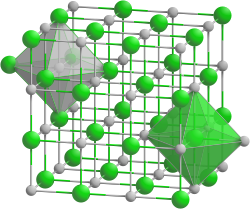Lithium hydride
| Crystal structure | |||||||||||||||||||
|---|---|---|---|---|---|---|---|---|---|---|---|---|---|---|---|---|---|---|---|

|
|||||||||||||||||||
| __ Li + __ H - | |||||||||||||||||||
| General | |||||||||||||||||||
| Surname | Lithium hydride | ||||||||||||||||||
| Ratio formula | LiH | ||||||||||||||||||
| Brief description |
white odorless solid |
||||||||||||||||||
| External identifiers / databases | |||||||||||||||||||
|
|||||||||||||||||||
| properties | |||||||||||||||||||
| Molar mass | 7.95 g mol −1 | ||||||||||||||||||
| Physical state |
firmly |
||||||||||||||||||
| density |
0.78 g cm −3 |
||||||||||||||||||
| Melting point |
688 ° C |
||||||||||||||||||
| solubility |
reacts violently with water |
||||||||||||||||||
| safety instructions | |||||||||||||||||||
|
|||||||||||||||||||
| MAK |
Switzerland: 0.025 mg m −3 (measured as inhalable dust ) |
||||||||||||||||||
| As far as possible and customary, SI units are used. Unless otherwise noted, the data given apply to standard conditions . | |||||||||||||||||||
Lithium hydride LiH is a salt-like chemical compound of lithium and hydrogen . Since lithium hydride is very stable, in connection with the low molar mass of lithium it represents an excellent hydrogen storage device with a capacity of 2.8 m³ hydrogen per kilogram. The hydrogen can be released by reacting with water.
Extraction and presentation
Lithium hydride is produced by reacting liquid metallic lithium with molecular hydrogen at 600 ° C.
properties
Physical Properties
Lithium hydride is a white to gray, flammable powder which, with a density of 0.76 g / cm³, is one of the lightest non- porous solids. It melts at 688 ° C. The enthalpy of formation is −90.43 kJ / mol.
Chemical properties
Lithium hydride is flammable, so it reacts with oxygen . This creates lithium hydroxide :
It reacts with water, acids and bases releasing hydrogen:
It reduces or hydrogenates organic compounds , for example formaldehyde to methanol :
Lithium hydride begins to decompose at 900–1000 ° C into elemental lithium and hydrogen , making it the most thermally stable alkali metal hydride.
When heated in a stream of nitrogen , lithium nitride is formed . Lithium amide (LiNH 2 ) and lithium imide (Li 2 NH) are formed as intermediate stages .
use
Lithium hydride is used as a reducing agent for the production of hydrides and double hydrides . It is also used to deprotonate CH-acidic compounds. Another area of application is the production of the hydrogenating agents lithium boranate and lithium alanate .
Due to its high dipole moment , lithium hydride is of interest in connection with the Bose-Einstein condensation of ultra-cold atoms.
Lithium deuteride
In Lithiumdeuterid (LiD) is deuterated lithium hydride, d. That is, the hydrogen isotope deuterium was used instead of normal hydrogen. Lithium deuteride is one of the core components of the solid hydrogen bomb , which has greatly simplified the storage and handling of the otherwise gaseous deuterium and the generation of the tritium required for fusion .
safety instructions
Since lithium hydride reacts strongly exothermic with common fire extinguishing agents like water , carbon dioxide , nitrogen or carbon tetrachloride , fires with inert gases like z. B. argon can be deleted.
Individual evidence
- ↑ a b c d e f g h Entry on lithium hydride in the GESTIS substance database of the IFA , accessed on January 8, 2018(JavaScript required) .
- ↑ Swiss Accident Insurance Fund (Suva): Limit values - current MAK and BAT values (search for 7580-67-8 or lithium hydride ), accessed on November 2, 2015.
- ↑ a b c d e E. Riedel : Inorganic Chemistry. 5th edition. de Gruyter, Berlin 2002, ISBN 3-11-017439-1 , pp. 612-613.
- ^ R. Abegg , F. Auerbach , I. Koppel: Handbuch der inorganic Chemie . Volume 2, Part 1, Verlag S. Hirzel, 1908, p. 120. (full text)
- ^ DA Johnson: Metals and chemical change. Volume 1, Verlag Royal Society of Chemistry, 2002, ISBN 0-85404-665-8 , p. 167. ( limited preview in Google book search)
- ^ KA Hofmann: Textbook of Inorganic Chemistry. 2nd Edition. Verlag F. Vieweg & Sohn, 1919, p. 441. (full text)
- ^ IV Hertel , C.-P. Schulz: Atoms, Molecules and Optical Physics. Volume 2, Springer Verlag, 2010, ISBN 978-3-642-11972-9 , p. 80. ( limited preview in Google book search)
- ↑ Richard Bauer: Lithium - as it is not in the textbook. In: Chemistry in Our Time. 19, 1985, pp. 167-173. doi: 10.1002 / ciuz.19850190505 .
- ^ Rutherford Online: Lithium
- ↑ F. Ullmann, W. Foerst: Encyclopedia of technical chemistry. Volume 8, 3rd edition. Verlag Urban & Schwarzenberg, 1969, p. 723. ( limited preview in Google book search)











